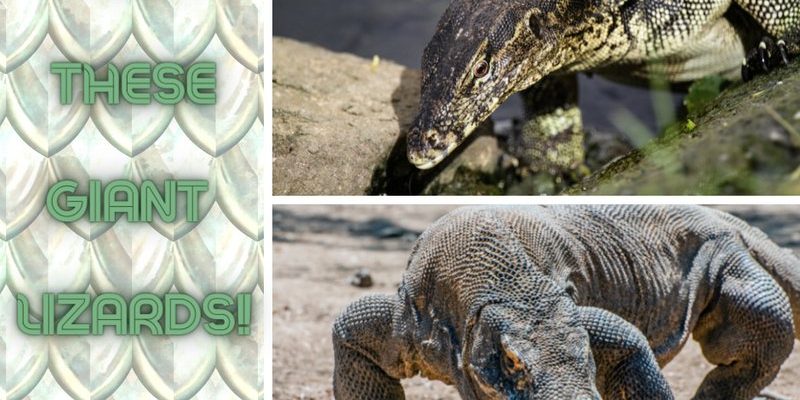![Komodo Dragon Vs. [Similar Species] - How They Compare](https://gudri.com/wp-content/uploads/2025/06/Komodo_Dragon_Vs___Similar_Species____How_They_Compare_image_0.jpg)
In this article, we’ll dive deep into the Komodo dragon and compare it with some similar species, like the monitor lizards and the Iguana. Think of it like comparing two great athletes or famous artists; both have their own strengths and quirks. So, grab your coffee, and let’s explore how these creatures stack up against each other!
What is a Komodo Dragon?
The Komodo dragon is the largest lizard on the planet, reaching lengths of up to 10 feet and weighing over 150 pounds. Native to islands like Komodo, Rinca, and Flores, these reptiles stand out with their rough, scaly skin and powerful limbs. Picture a living dinosaur, and you’re in the right ballpark!
These creatures are carnivorous, feeding on various prey, including deer, birds, and even other Komodo dragons. They rely on their keen sense of smell to track down food, using their long tongues like a forked radar. And here’s the kicker: when they bite their prey, they release bacteria-laden saliva. This means that even if their prey escapes, it could succumb to infection later.
Common Traits of Similar Species
When comparing the Komodo dragon to similar species, there are a few key traits to explore. For instance, both Komodo dragons and monitor lizards belong to the same family—Varanidae. This means they share certain characteristics, such as being carnivorous and having powerful jaws.
Monitor lizards, like the Savannah monitor, can be smaller than the Komodo, but they exhibit similar hunting behaviors. They also have sharp claws and quick reflexes, making them proficient hunters in their own right. And just like the Komodo, many monitor lizards use their keen sense of smell to find food.
The Size and Appearance Showdown
One of the most striking differences between the Komodo dragon and other similar species is their size. As I mentioned earlier, Komodos can grow up to 10 feet long; in contrast, most monitor lizards only reach about 4 to 6 feet.
Here’s a quick comparison:
| Species | Maximum Length | Weight |
| Komodo Dragon | Up to 10 ft | Up to 150 lbs |
| Savannah Monitor | About 4 ft | Up to 15 lbs |
| Iguana | About 6.5 ft | Up to 20 lbs |
As you can see, the Komodo dragon takes the crown for size! It’s not just about length, though; their robust build and muscular bodies give them a commanding presence that smaller lizards simply can’t match.
Habitat and Distribution
The Komodo dragon primarily inhabits dry, hot islands, specifically in Indonesia. They thrive in savannahs, open grasslands, and low woodlands, making their homes in areas with ample sunlight and access to prey.
In contrast, the monitor lizards are more diverse in habitat. They can be found in various regions, including rainforests, deserts, and even in urban areas. This adaptability gives them an edge when it comes to living in different environments. Meanwhile, Iguanas prefer tropical and subtropical climates, often found near water sources like rivers and streams.
In summary, while all these reptiles share some habitat preferences, the Komodo dragon is more specialized in its specific island dwellings, while its relatives have a broader range.
Feeding Habits and Hunting Techniques
Feeding habits can greatly differ among these species, and it’s one of the fascinating areas where they shine. The Komodo dragon is a top predator, primarily hunting large prey. Its hunting strategy is a mix of stealth and brute force. They tend to ambush their prey, using their size to overpower it.
In contrast, monitor lizards can be opportunistic feeders. While some species hunt large prey like the Komodo, others may also eat insects, small mammals, and even plants! This flexibility in diet helps them survive in various environments.
On the other hand, Iguanas are primarily herbivores, munching on leaves, flowers, and fruits. Their diet is vastly different from both the Komodo dragon and monitor lizards, showcasing how diverse these reptiles can be in their feeding habits.
Behavior and Social Structure
When it comes to behavior, the Komodo dragon is often a solitary creature. They typically wander alone and only come together during mating season. Their dominant nature means they have a strict social hierarchy, especially when it comes to feeding.
Monitor lizards, depending on the species, might display more social behaviors. Some can be found basking together or even forming loose groups while hunting. Meanwhile, iguanas can sometimes be seen in groups, especially during breeding season.
It’s intriguing how social dynamics can vary so much between similar species!
Conservation Status and Threats
Conservation is another crucial area to look at. The Komodo dragon is considered vulnerable, with habitat loss and poaching being significant threats. Conservation efforts are in place, but climate change poses an additional challenge.
Monitor lizards usually have a more stable population, but specific species can be threatened due to habitat destruction and illegal pet trade. As for Iguanas, they face similar threats, particularly loss of habitat and hunting in some areas.
It’s pivotal to understand that while they may share similarities, the conservation status of these species can differ greatly.
Wrapping It Up: Komodo Dragon vs. Other Giants of the Reptile World
In the grand world of reptiles, the Komodo dragon stands out for its size, hunting prowess, and solitary lifestyle. When we look at similar species like monitor lizards and iguanas, we see a fascinating array of similarities and differences. Each has adapted uniquely to its environment, showcasing the diversity of life on our planet.
Whether it’s the Komodo’s mighty bite or the monitor’s agility, each species plays a significant role in its ecosystem. Understanding these creatures not only fascinates us but also highlights the importance of conservation efforts to protect them for future generations. So next time you think of the mighty Komodo dragon, remember it’s just one piece of the incredible puzzle that makes up our world of reptiles!

